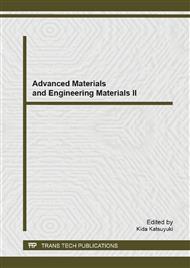[1]
G. Schumacher, Coal pulverising mill types, ISBN 978-0-646-53759-7, (2010).
Google Scholar
[2]
M. J. Daniel, S. Morrell. HPGR model verification and scale-up. Minerals Engineering, 17 (2004)1149-1161.
DOI: 10.1016/j.mineng.2004.05.016
Google Scholar
[3]
C. E. Özer, W. J. W hiten. A multi-component appearance function for the breakage of coal. International Journal of Mineral Processing, 104-105 (2012)37-44.
DOI: 10.1016/j.minpro.2011.11.014
Google Scholar
[4]
M. Torres, A. Casali, A novel approach for the modelling of high-pressure grinding rolls, Minerals Engineering, 22 (2009)1137-1146.
DOI: 10.1016/j.mineng.2009.04.011
Google Scholar
[5]
A. M. Abouzeid, D. W. Fuerstenau, Grinding of mineral mixtures in high-pressure grinding rolls, International Journal of Mineral Processing, 93 (2009)59-65.
DOI: 10.1016/j.minpro.2009.05.008
Google Scholar
[6]
H. Benzer, N. A. Aydogan, H. Dundar, Investigation of the breakage of hard and soft components under high compression: HPGR application, Minerals Engineering, 24 (2011)303-307.
DOI: 10.1016/j.mineng.2010.09.012
Google Scholar
[7]
W. I. L. Lim, J. J. Campbell and L. A. Tondo, The effect of rolls speed and rolls surface pattern on high pressure grinding rolls performance, Minerals Engineering, 10 (1997)401-419.
DOI: 10.1016/s0892-6875(97)00017-4
Google Scholar
[8]
L. B. Lucy, A numerical approach to testing of the fission hypothesis, The Astronomical Journal, 82 (1977)1013-1024.
Google Scholar
[9]
R. A. Gingold, J. J. Monaghan, Smoothed particle hydrodynamics: theory and application to non-spherical stars, Monthly Notices of the Poyal Astronomical Society, 181 (1977)375-389.
DOI: 10.1093/mnras/181.3.375
Google Scholar
[10]
J. J. Monaghan, Smoothed particle hydrodynamics, Rep. Prog. Phys., 68 (2005)1703-1759.
DOI: 10.1088/0034-4885/68/8/r01
Google Scholar
[11]
R. Das, P. W. Cleary, Effect of rock shapes on brittle fracture using Smoothed Particle Hydrodynamics, Theoretical and Applied Fracture Mechanics, 53 (2010)47-60.
DOI: 10.1016/j.tafmec.2009.12.004
Google Scholar
[12]
G. W. Ma, X. J. Wang, and Q. M. Li, Modeling strain rate effect of heterogeneous materials using SPH method, Rock Mech Rock Eng 43 (2010)763-776.
DOI: 10.1007/s00603-010-0089-2
Google Scholar
[13]
J. O. Hallquist, LS-DYNA theory manual, Livermore Software Technology Corporation, Livermore, California, (2006).
Google Scholar
[14]
P. W. Randles, L. D. Libersky, Smoothed particle hydrodynamics: some recent improvements and applications. Comput Methods Appl Mech Eng, 139 (1996)375-408.
DOI: 10.1016/s0045-7825(96)01090-0
Google Scholar
[15]
L. D. Libersky, A. G. Petschek, Smooth particle hydrodynamics with strength of materials, in: Trease and Crowley (eds. ), Advances in the Free-Lagrange Method, Springer, Berlin, 1990, pp.248-257.
DOI: 10.1007/3-540-54960-9_58
Google Scholar
[16]
L. J. Malvar, J. E. Crawford, J. W. Wesevich et al, A plasticity concrete material model for DYNA3D. Int. J. Impact Eng. 19 (1997)847-873.
DOI: 10.1016/s0734-743x(97)00023-7
Google Scholar
[17]
L. J. Malvar, J. E. Crawford, and K. B. Morrill, K&C Concrete Material Model Release III - Automated Generation of Material Model Input. K&C Technical Report TR-99-24-B1, (2000).
Google Scholar


